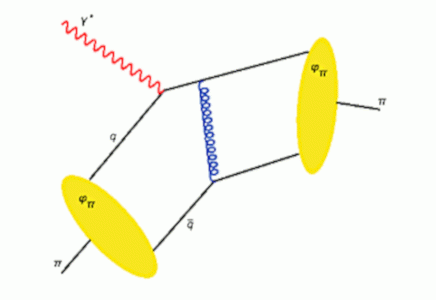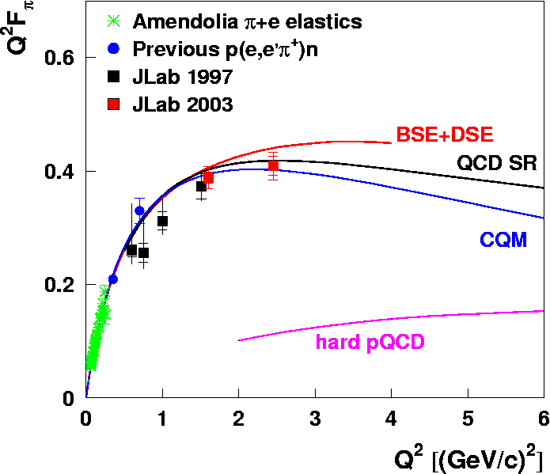Pion Form Factor

The pion form factor in leading order pQCD.
Additional Links

Pion form factor results from the two JLab Hall C experiments. Also shown are e-pi elastic data from CERN and earlier pion electroproduction data from DESY. The curves are from a Dyson-Schwinger equation (Maris and Tandy, 2000), QCD sum rule (Nesterenko, 1982), constituent quark model (Hwang, 2001), and a pQCD calculation (Bakulev, 2004).
In research carried out in Jefferson Lab's Hall C, the Fπ collaboration is studying how the strong force combines nature's fundamental building blocks into the lightest particle built of quarks: the pion – which is arguably the most important of the mesons due to its Goldstone nature (it has an unusually small mass). We can naively picture the pion as consisting of one each of the lightest quarks and anti-quarks. As with all quark-based particles, however, a more realistic description of the pion also includes the quark-gluon sea: a strong-force driven bevy of quarks, anti-quarks and gluons popping into and out of existence and providing the foundation of the pion's structure.
This structure is mapped out by a single form factor (Fπ), which provides information about the distribution of charge inside the pion. By measuring Fπ at ever shorter distances, it is possible to study its transition from a particle where the quark-gluon sea plays a significant role in its structure to what looks like a simple quark-antiquark system.
In 2001, Jefferson Lab provided the first high precision pion electroproduction data for Fπ between Q2 values of 0.6 and 1.6 (GeV/c)2. The new result, at Q2=2.45 (GeV/c)2, is still far from the transition to the Q2 region where the pion looks like a simple quark-antiquark pair and is providing a stringent test for models that attempt to incorporate the important "softer" quark sea contributions. Plans are now being made to access the transition region with the higher-energy electron beam proposed for the 12 GeV Upgrade at Jefferson Lab. The Upgrade will allow an extension of the Fπ measurement up to a value of Q2 of about 6 (GeV/c)2, which will probe the pion at double the resolution.
References:
T. Horn et. al., Phys. Rev. Lett. 97 (2006) 192001
V. Tadevosyan et al., Phys. Rev. C 75 (2007) 055205
J. Volmer et al., Phys. Rev. Lett. 86 (2001) 1713

